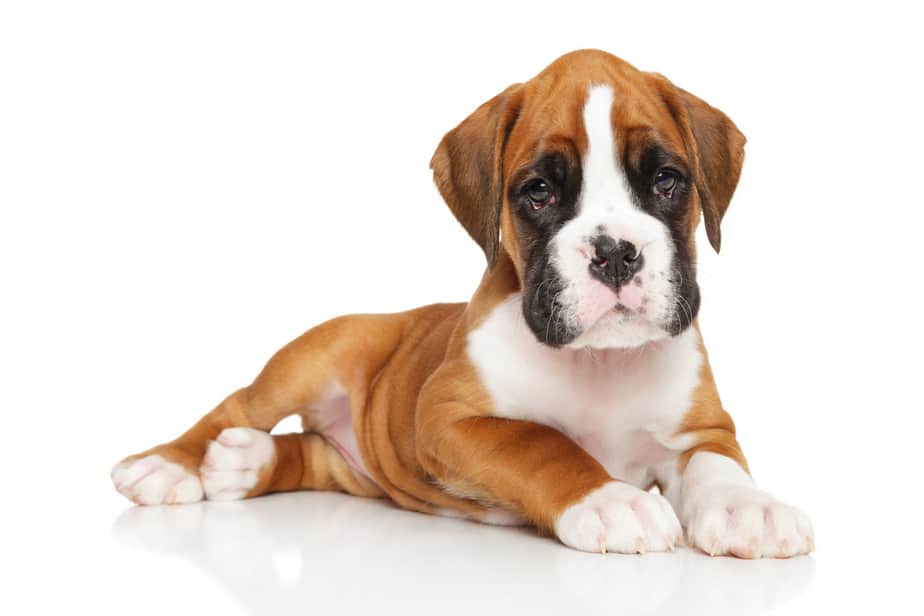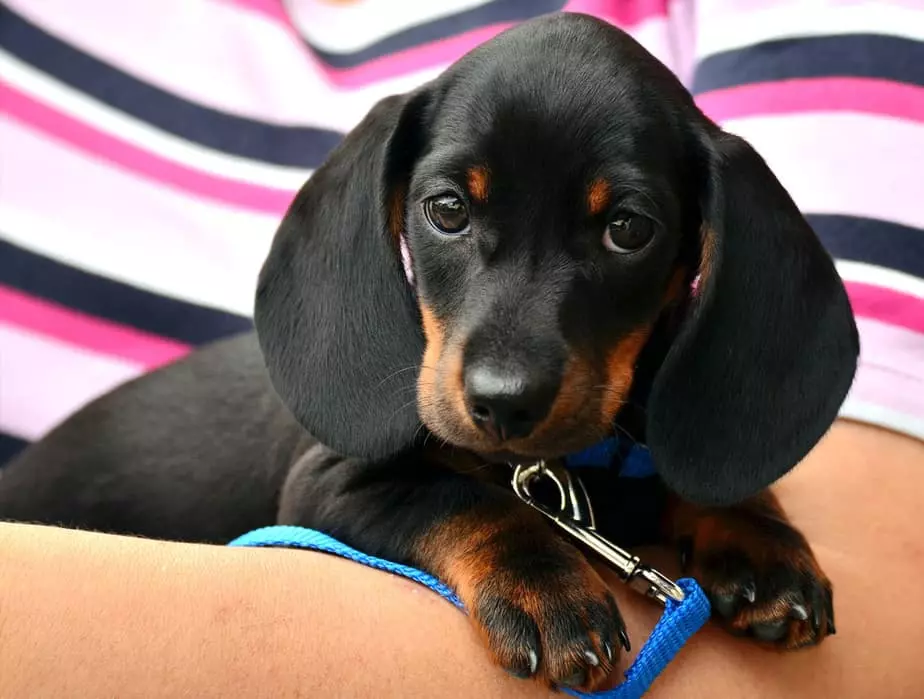Some dogs, especially puppies, may have a large spot on the back of their skull that makes them look like they have a pointy head. This phenomenon is often called having a pointy head puppy or a cone shaped head puppy.
In this article, we’ll be exploring the reasons for a pointy head on your puppy, if you should be concerned about it, and breeds that are prone to this condition. We will also look at the idea that the size of a dog’s occiput can determine their intelligence, as well as what intelligence in dogs looks like.
What Causes a Pointy Head Puppy?
The bump on the back of a puppy’s head that causes them to look like a pointy head puppy is officially known as the occiput. This part of the skull is present in all dogs, although it isn’t as noticeable in all breeds.
In the majority of cases, a pronounced occiput is perfectly normal in a growing puppy.
The purpose of the occiput is to protect your puppy’s skull. This bone actually connects to your dog’s neck, as it runs down the back of your puppy’s head.
Even though this part of your dog is called the occiput, it is colloquially called a variety of names. Some of these names include:
- Knowledge bump
- Smart bump
- Intelligence knot
- Jumper’s bump
- Cone head
Not only is the occiput responsible for protecting your dog’s head, but it contains a lot of nerve endings associated with the fight or flight system as well. Because of this, it’s a common spot to focus on in canine massage.
There is also some evidence that the occipital region of a dog’s head is more pronounced in male dogs than in female dogs, particularly the protuberance and crest that are noticeable visually.
Besides protecting your dog’s head, the crest of the occiput provides a region for a variety of muscles in your dog’s head to easily attach. These muscles help extend and rotate their head.
Are you interested in reading our post, Puppy’s First Cut: How old should they be?

Breeds Prone to Pointy Heads
There are breeds more prone to pointy heads or cone shaped heads. Two of the breeds that most commonly have a pronounced occiput are:
- Labrador Retrievers
- Boxers
As puppies, Labrador Retrievers and Boxers go through a variety of changes as they grow. Sometimes, that includes having a large occipital protuberance that looks like an awkward cone shape on the top of their head.
In the majority of cases, this is something that goes away with age. However, if you are concerned, you can absolutely have your veterinarian take a look at your puppy.
Sometimes, you’ll notice the large occiput even in a very young puppy, only a few weeks old. Other times, the point appears larger as your puppy is a few months old and growing.
In either case, you’ll likely see your puppy’s head even out and appears more normal by the time they are 7-10 months old.
While Labrador Retriever and Boxer puppies are two of the breeds most commonly known for sometimes having a cone shaped head as puppies, other dogs can be affected as well.
Other breeds prone to a puppy head bump can include:
- English Setters
- Golden Retrievers
- Bloodhounds
- Pointers
- Spaniels
Occiputs are also easy to see in many dogs with long noses, such as Collies, Doberman Pinschers, and German Shepherd Dogs.
Are you interested in reading our post, Petco vs PetSmart: Which is Better 2023

Does a pointy head mean health problems?
While a large, pointy, occiput in young puppies is not necessarily a cause for concern, there are some health concerns that can be associated with a pronounced occiput.
If you notice any large changes in the occiput, or you find any additional bumps on the dog’s head, it’s definitely cause for concern. The changes that occur around the occiput in an adolescent puppy should not be drastic.
There are several conditions that cause the occiput to appear more pronounced, especially those that cause a degradation of the muscles that attach to the occiput.
One of those conditions is called masticatory muscle myositis. This condition, also known as MMM, is an autoimmune disorder.
In MMM, the dog’s body thinks that the muscles in the jaw are foreign, and doesn’t recognize it as its own. As these muscles are attacked by the body, they become swollen, painful, and can waste away.
The breeds prone to masticatory muscle myositis also happen to be some of the breeds prone to a large and pointy occiput as puppies, including:
- Golden Retrievers
- Doberman Pinschers
- German Shepherds
- Labrador Retrievers
- Cavalier King Charles Spaniels
This condition can also be found in puppies as young as 4 months, although the average case of MMM is diagnosed closer to 3 years of age.
Not only will dogs with MMM have a pronounced occiput, due to the lack of muscle, but other symptoms are common.
Dogs with MMM will often have an inability to open their mouth and extreme pain in their face. While these symptoms are common to MMM, the official diagnosis occurs through a muscle biopsy or a blood test.
Diagnosed early, MMM is treatable. This is one of the reasons that you should take your puppy to the veterinarian if you notice changes in them or their structure, including the pain associated with MMM.
If you are choosing a puppy and it has an odd-shaped head, it’s also worth a vet visit before purchasing the puppy. A responsible breeder should have no problem with you taking the puppy to your own veterinarian for an exam, if they haven’t already had the puppy in themselves.
Do you want to read about playing rough with your puppy and if it’s OK? Read our post about it here.
Does a pointy head indicate intelligence in my puppy?
It’s long been thought that a pointy head could indicate higher intelligence, especially since the pronounced occiput is seen on breeds that are commonly thought of as smart, such as the retrievers and hounds.
The bump is often referred to as the “Smart Bump” or the “Knowledge Bump” after all.
However, this is simply an old wive’s tale, and there is a lot more that goes into the intelligence of a dog than the shape of their head.
In fact, intelligence in general is hard to rank in dogs. There are many types of dog breeds, bred for a variety of different purposes.
On one schedule of intelligence, a Labrador Retriever may rank incredibly well for their ability to work with their owner and their high level of train-ability. On the same test, a Siberian Husky may perform terribly, since they are a more independent breed.
However, that doesn’t mean the Siberian Husky is not intelligent. If you considered their ability to run as a sled dog, determine safety, and exhibit intelligent disobedience to keep the group of dogs and people safe when on the trail, they will far outperform a Labrador Retriever.
Rather than being associated with intelligence, the pointy head of a dog is simply a matter of skull structure.
Maybe you would be interested in this: Leaving your dog home alone, how long is OK?
Final Thoughts
While some puppies, especially Labrador Retriever and Boxer puppies, may have the appearance of a cone shaped head, it’s not usually a cause for alarm.
The shape of their head often evens out to a more normal head shape during adolescence, although they may still have an occiput that is more pronounced than in other breeds.
Unless the changes to your dog’s occiput appear suddenly or are also associated with pain, the risk of it being associated with significant health problems is low.
The structure on their head that can contribute to the pointy headed appearance is simply a ridge in the skull that helps protect their brain, along with connecting the head to the neck.
This structure, known as the occiput, is simply varied within some breeds and individuals, and is not a measure of their intelligence – even though it is sometimes referred to as the knowledge bump.
Of course, it also goes without saying that this bump doesn’t detract at all from what a gorgeous animal they all truly are.
Would you like to read our post, Puppy Humping: Is it normal and what to do?




